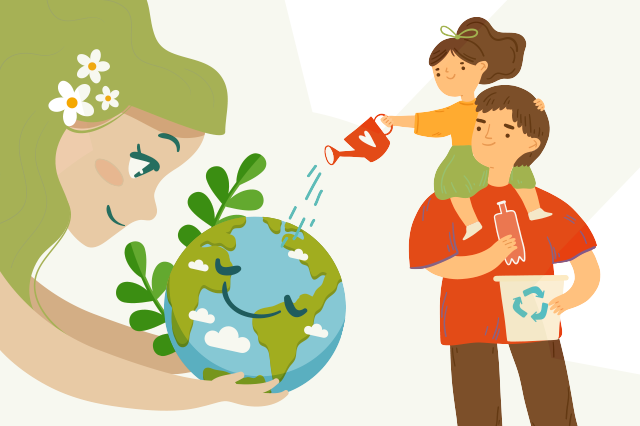As the world faces the effects of climate change, it is becoming increasingly clear that we all have a role to play in protecting the environment.
While people tend to focus on personal habits, reducing their use of plastic and shifting to a vegetable diet, the area that is often overlooked is the workplace.
Offices and employees can significantly reduce their carbon footprint and contribute to a more sustainable future. From reducing paper usage to investing in energy-efficient equipment, many steps can be taken to make offices and employees «more environmentally friendly.»
According to the United States Environmental Protection Agency, buildings contribute 39% of CO2 emissions.
Ten simple steps that offices and employees can take to become «greener» and reduce their environmental impact:
Reduce paper usage. Offices can reduce paper use by switching to digital technology and implementing a paperless system. Staff can also contribute by using both sides of the paper or by using unnecessary notes paper.
According to the Paperless Project, an average office worker uses 10,000 sheets of paper a year, and 45% of that paper goes into the garbage. For example, if a company of 500 employees were to give up paper, they could save up to 2.5 million sheets of paper a year.
Switch to energy-saving lighting. Replacing incandescent lamps with energy-saving LED lamps can save energy and money in the long run.
The International Energy Agency predicts that by 2050, global electricity demand will grow by 70 percent, and buildings will account for more than half of that demand.
Encourage the use of environmentally friendly transport. Encouraging employees to share cars, bicycles, or public transport can significantly reduce carbon emissions.
Environmental Protection Fund sources report that the carbon footprint of one employee en route to work can reach six metric tons of CO2 emissions per year.
Use environmentally friendly cleaning products. Switching to environmentally friendly cleaning products can reduce the amount of harmful chemicals released into the environment.
Keep the recycling going. Encouraging employees to recycle paper, plastics, and other materials can significantly reduce the amount of waste going to landfills.
Many companies in Almaty and Astana cooperate with paper collection and processing organizations. Each office can find out if there are such organizations in their city and organize the collection and removal of garbage for recycling.
Transition to digital technology. Eliminating the need for physical copies of documents through digitization can significantly reduce paper waste and storage space.
Introduction of energy-saving measures. Offices can implement energy-saving measures such as turning off equipment when not in use, adjusting temperature, and using natural light.
According to Energy Star calculations, an office building can consume up to 30% less energy using energy-efficient lighting and equipment.
Use reusable products. Encouraging employees to bring their reusable water bottles, coffee cups, and lunch containers can significantly reduce waste.
Today in many offices, there is food delivery: employees order lunch, and the company, through suppliers, buys boxes with ready food for employees. The best alternative would be to eat at home or bring food in your reusable container. But only some have this opportunity. «The management, where I work now, has an interesting concept,» - shared the experience of Alina Dossanova, ecologist, Eco Network in Kazakhstan.
They agreed with the cafe opposite the work to give meals to employees on coupons. The company covers 50% of the cost; employees eat a packed lunch for 1000 tenge. Now, even at home, you can’t buy anything to cook adequately. Some companies can cover 100% of meals. At the same time, in the cafe, they eat with reusable dishes and can take the leftovers (using containers or a container from the cafeteria that can later be washed and used to plant microgreens), she continued.
Invest in environmentally friendly office equipment. Purchasing energy-efficient office equipment such as printers, computers, and monitors can reduce energy consumption.
Support local environmental initiatives. Offices can support local environmental initiatives, such as community clean-up events or sponsoring local ecological projects.
"We have a built-in filter in our office, employees were given thermoses/therm mugs, and everyone uses them or uses reusable cups. There are no dispensers in our office. That means we don't have to buy bottled water. Many offices, unfortunately, have dispensers, Alina Dosssanova said.
There's also a tip for offices with coffee machines. "We also have a coffee machine in our office, and if before the coffee leftovers were thrown away, today colleagues use it for pilling with coffee cake at home," Alina shared. "And we also use it to mulch indoor plants to water them less often," she continued.
These simple steps can be significant. Offices will save money on printing costs and reduce waste sent to landfills. Energy-efficient lighting and equipment will save money and reduce carbon emissions. Using eco-friendly cleaning products and encouraging recycling will reduce the amount of harmful chemicals released into the environment.
Implementing these steps can also positively impact employee morale and productivity. A green workplace can lead to increased employee engagement and loyalty.
Examples of best practices include companies such as Patagonia, which seeks to reduce the environmental impact of its products and operations. The company uses recycled materials in its products and has implemented energy-saving measures in its stores and offices. Another example is Google, which has committed to achieving carbon neutrality by 2020 and has invested in renewable energy projects to reduce its carbon footprint.
The data and statistics in this article demonstrate the urgency and importance of taking action to make offices and employees greener. By implementing sustainable practices and reducing our carbon footprint, we can work toward a more sustainable future and a healthier planet for future generations.
The article is produced in collaboration with Eco Network Kazakhstan https://econetwork.green/.




















